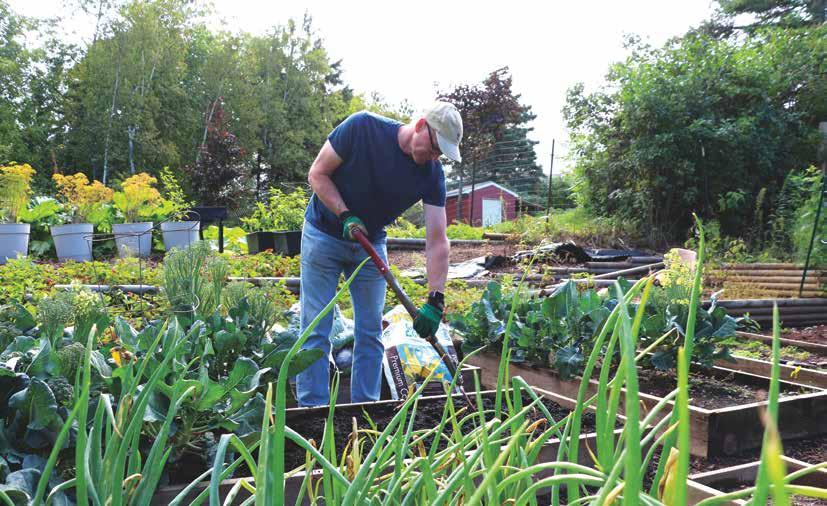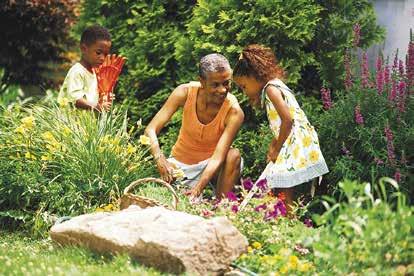
3 minute read
Next steps in post-pandemic gardening: building skills, building soils
By Sarah Lerohl
Spring
2020 was unlike any other — in a million different ways. As the budding COVID-19 pandemic shut down traditional entertainment venues and general insecurity mounted about food availability, residents turned toward home gardening for entertainment, stress relief, fresh food and bright blooms.
A whole new crop of gardeners cultivated seeds of curiosity and harvested a healthy new pastime, along with the rewards of the growing season. Now, it’s time to harness that excitement and keep the enthusiasm going into this season.
New urban gardeners often choose raised bed gardens — an elevated box filled with enough soil to support plants without using the soil beneath the box — as they offer some tantalizing benefits. Raised beds provide well-defined garden boundaries for lovers of order (and help keep plant diseases from spreading). They allow gardening on sites where soils may be unsuited for gardening, and best of all, raised beds can make gardening much more comfortable by limiting the bending required to get into the dirt. Since raised beds are filled by the gardener with the desired soil substrate, they often have better soil structure and drainage than the surrounding earth and they will certainly warm up more quickly in the spring.
No matter your preference, whether in the native soil or above it, your best bet for great quality dirt always begins with a soil test. University of Minnesota Soil Testing Laboratory (soiltest.cfans.umn.edu) provides detailed instructions for taking samples at home, submitting them and interpreting the results when they are returned. Soil quality is key for continued success.
Garden Green compost is produced in Duluth from local food scraps and yard waste, providing a stable source of organic matter for raised beds and traditional gardens.
Garden soil characteristics change over multiple growing seasons, even in raised beds, with the slow breakdown of soil particles and organic matter — the part of soil made from dead plants and animals — and as plants uptake nutrients. Even if you built raised bed gardens and filled them with the exact type of soils required for the plants you grow, things change. If you started a pandemic garden without soil testing, no problem, it’s never too late. If it’s been a few years since testing in a well-established plot, take the time to do one this year. Results will help you understand what, if any, fertilizers or soil amendments are needed.
A recent study out of Oregon State University found that some urban gardens actually contain too much organic matter, and that can pose problems. It can be tempting to add more organic matter than is necessary because manures and composts can be obtained easily at most garden centers, but your first concern should be the inorganic part of the soil, the mineral portion ultimately made of broken down rocks. The minerals and nutrient byproducts of breakdown provide the building blocks the plants need to build tissue. The inorganic particles create the basic structure of the soil that helps to root plants and make water available.
Organic matter helps the plants access all the inorganic goodness by “opening up the soil,” making space and room for tender roots to penetrate. Organic matter acts as a juicy sponge, retaining water within the soil structure, and will very slowly add further nutrient content as it breaks down. The presence of organic matter brings all the “critters to the yard,” providing ample fuel for a vibrant soil community of bacteria, fungi and other organisms that boost fertility.

The risks associated with adding excessive organic matter, like “burning” plants with extra nutrients, are minimized when using a thoroughly composted, stable product like WLSSD’s Garden Green compost, but gardeners are wise to remember that it is possible to have too much of a good thing.
There aren’t hard-and-fast rules for how much organic matter soils contain, but the U.S. Composting Council recommends aiming for 5% to 10% in your home veggie or flower beds. Organic matter can be added to your garden in the form of homemade or commercial composts made from yard waste, food scraps, manure, or a combination of feedstock. Top dress existing gardens with compost as recommended by your test results, and plan on adding a couple of inches annually going forward.

As amazing as compost is, plants cannot grow on compost alone — but soil blended with compost? That’s a recipe for success. Learn more about the best blends of soil and Garden Green compost for your project at wlssd.com. D










